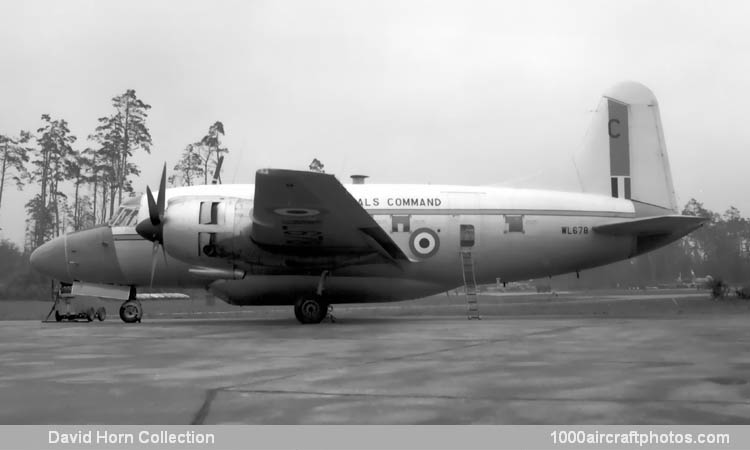04/30/2010. Remarks by Johan Visschedijk: "Although the Wellington T.Mk.10 and the Valettas T.Mk.3 and T.Mk.4 were rendering valuable service in aircrew training in the immediate post-war period, it became necessary to re-equip Flying Training Command with a more modern type which could completely satisfy all multi-engined needs. Specification T.13/48 was written to cover this requirement, and Vickers submitted a specialized design as a development of the Viking and Valetta family.
This Valetta-type training aircraft, which in the event was the last of Vickers aircraft to use the piston engine as prime mover, was appropriately named the Varsity T.Mk.1 in November 1949. It was somewhat larger than the Valetta, with a wider span and an all-up weight increased by 1,000 lb (456 kg). Appreciable improvement was made in performance, cruising speed, climb, ceiling and range, compared with the performance of the Valetta. In this development the Varsity design benefitted considerably from the emerging concept of the VC2 Viscount at that time.
Most notable feature of the Varsity was the use of a Viscount-type nose wheel landing gear. Another distinguishing feature was the fixed ventral pannier accommodating the bomb-aimer's prone position forward and his 24 practice bombs of 25 lb (11 kg) each aft, this external appendage leading to a somewhat undignified name for the Varsity. One practical problem had to be solved, and that was the clouding of the bomb-sighting window by mud or dust thrown up by the twin nose wheels; neat mudguards overcame this trouble.
Engineering development was evident in the Varsity design. Clam-shell low-drag engine cowlings were fitted to promote quick accessibility to the engine controls, services and accessories. Other details for servicing and maintenance set a new note of efficiency which continued on into the propeller-turbine and turbojet aircraft which followed.
Captain J. 'Mutt' Summers flew the Varsity prototype VX828 on July 17, 1949, from Wisley, with G.R. 'Jock' Bryce as co-pilot. A second prototype, VX835, followed on January 29, 1950, and the first deliveries were made to replace Wellingtons in No. 201 Advanced Flying School at Swinderby at the end of 1951.
Varsities were used by Flying Training Command for pilots converting to multi-engined aircraft before proceeding to Hastings, Washingtons, Shackletons and Britannias, and for advanced instruction to navigators and bomb-aimers, continuing in service until the late 1960s and reducing the wastage rate of this command by 50%. By virtue of its ultimate range of 2,600 mls (4,184 km), the Varsity was ideal for long-distance navigational training and also as a stand-in bomber during operational exercises of the RAF. Latterly, the Varsity was put into service by RAF Signals Command.
Varsities WF 412, 417 and WL665 have been used in the lengthy research conducted by the Royal Aircraft Establishment into automatic landing systems for aircraft. This investigation was started in 1949 by the Blind Landing Experimental Unit, first at MartIesham and then at Bedford, although as early as 1923, a Vickers Vimy bomber was used by the RAE for the experimental trials of an automatic landing device based on a mechanical trip system.
For their particular contribution to the development of automatic landing, Smiths Aviation Division used Varsity G-ARFP, which was converted by the College of Aeronautics at Cranfield for this purpose. The ventral blister was removed, reinforced steel spars were fitted to ensure adequate fatigue life, a dual braking system was introduced and the interior of the cabin was rebuilt to accommodate the specialized equipment racks. The Decca Co. used Varsity G-APAZ for development work with their navigational system, but this aircraft was written off in a crash unconnected with the work in hand.
One Varsity, WF416, was converted by Eagle as a personal transport for King Hussein of Jordan (s/n VK-501), and the ventral bomb-aimer's pannier was removed, adding a few knots to the cruising speed. The Air Ministry sold one to the Royal Swedish Air Force under designation Tp 82 (s/n 82001); one was used as a flying test bed for the Napier Eland propeller-turbine later installed in Convair-Liner conversions.
Seventeen Varsities, including the two prototypes, were Weybridge-built, and the other 146 were made at Vickers' factory at Hurn, Bournemouth, which was established in 1951 to relieve Weybridge of production load because of the parallel large-scale output there of Viscounts and Valiants:
Type 648 Varsity, prototypes, s/n VX828, VX835 (2)
Type 668 Varsity T.Mk.1, s/n WF324-WF335, WF369-WF 394, WF408-WF429,WJ886-WJ921, WJ937-WJ950, WL621-WL642, WL665-WL692
A civil version of the Varsity was projected under the class designation of VC3. It was intended as a conventional airliner for short-to-medium haul operations as a replacement for older aircraft in the DC-3 class and as an improved Viking. Meanwhile, the VC2 Viscount was on the threshold of unparalleled success, and the VC3 project was dropped.
The pictured aircraft was delivered to the RAF on September 29, 1953, and served with No. 527, No. 116 and No. 115 Squadrons before it was struck off charge on May 21, 1970. Subsequently it was used at Leeds Airport for fire practice."
